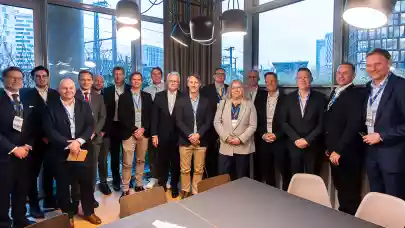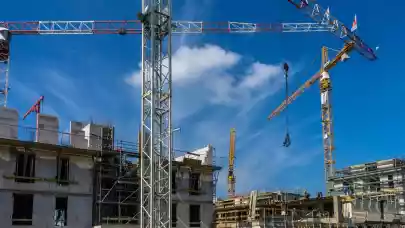
Bogdan Doicescu, CEO, Bog’Art Holding Management, spoke to Property Forum about the company’s expansion of its public works portfolio and the significant growth potential of the construction industry in the next period.
This interview was first published in Property Forum’s annual listing of "The 50 most influential people on Romania’s real estate market”.
What were some of Bog’Art Group’s operational and financial highlights during 2023 and what are your objectives for 2024?
With a turnover of approximately €200 million achieved in 2023, a team of 400 office employees and more than 1,300 site staff spread throughout the country, Bog’Art successfully managed over 35 projects spanning various sectors. These include office, residential, healthcare, airport, educational, urban, and infrastructure developments, covering an area of around 200,000 sqm.
We constantly aim to adopt new technology in the means and methods of efficient building with minimal waste as a vector of sustainable building in Romania. Bog’Art is a front-runner in this area as we are one of the first non-listed construction companies to publish an ESG report this year, underscoring our ongoing commitment to best practices driving the business forward.
At the same time, we are investing in technology such as file-sharing and collaborative platforms to enhance communication and employee productivity with real-time budget and design updates which are vital for our skilled workforce to work effectively in serving our many counterparties, subcontractors, and suppliers.
What is the share of public works in the group’s portfolio, and will new tender launches be impacted by the rounds of elections?
Over the course of 2023, Bog’Art smoothly transitioned from the private sector to a predominantly public works portfolio, showcasing the company’s agility in response to evolving circumstances. This is due to a sharp decline in private investments in the commercial and residential real estate sector with scarce new builds and the simultaneous expansion of significant public works.
Presently, our portfolio encompasses over 75% of public works across various types of projects such as hospitals, administrative facilities, sewage, and canal projects, educational and sports facilities, military bases, airports, and road infrastructure. Seeing the schedule of announced works to be tendered, regardless of political interests, Romania will be building substantially and intensely in the next years and the private sector will have to compete for the same resources.
What is your outlook for the Romanian construction market this year on costs and new demand?
Building on the previous point, it is important to note that the major cost components are influenced by unique fluctuations in material and labour prices that move in different ways, although demand is supported by strong economic growth forecasts and government initiatives.
On the labour side, costs are constantly rising and there is high demand, with challenges in finding and retaining skilled workforce for speciality works like water and canal works as well as general installations engineers, spread throughout the country pose significant upward pressure on prices.
In contrast, materials have high volatility, as some building materials have seen sharp declines, specifically window framing, gypsum board, brickwork and cladding or similar materials coming from much lower residential and civil works construction for example, while others such as piping and prefabricated metallic structures as well as reinforced steel pipes and rigid foundation cages are just waiting to boom when major infrastructure projects will take off at the same time.
Which real estate segments are generating the bulk of business for Bog’Art at present?
The primary areas driving the majority of Bog’Art’s business currently include infrastructure, healthcare, and various types of civil construction projects. Our ongoing projects encompass 4 airports, 5 hospitals, in Bucharest we are building many educational and administrative facilities in Sector 4 of Bucharest, Eroii Revolutiei station access and the Grant Overpass, recently opened for traffic.
Additionally, Bog’Art is involved in large strategic projects like the Nuclear U5 Cernavoda Unit and the Romanian Air Force 57th Air Base “Mihail Kogălniceanu”
How important are sustainable construction practices for real estate companies?
As a champion of sustainable construction in Romania, Bog’Art understands the paramount importance of integrating sustainable practices into its projects. This is not only for the sake of environmentally conscious impact as a must-have trend to follow but also because of our commitment to building in the best way possible to achieve long-term cost savings through operational efficiencies.
We believe that by monitoring our carbon emissions and aiming to reduce waste, we have an indirect benefit that meets our long-term outlook for a multi-generational business that will stand the test of time.
Undeniably, the commercial impact of sustainable buildings enhances our brand reputation, can achieve more favourable financing terms and ensures resilience in a competitive market.
What are the business opportunities for a construction group that develops its own real estate projects?
Developing our own real estate projects allows the Bog’Art Group of Companies to gain control over the entire project lifecycle, allowing us to optimize the plans from the urban-planning stage and to ensure our quality is maintained through to completion. Furthermore, developing our own real estate projects allows us to diversify revenue streams and mitigate risks associated with market fluctuations.
Our strategy is very clearly defined to develop mainly residential and build-to-hold boutique offices in can’t-miss locations, given opportune market and pipeline conditions. Strategic project selection, guided by our tried-and-tested experience, enables us to maximize returns in our own developments. Art City, our latest residential project, stands as a good example of our commitment to excellence and innovation, showcasing best practices for construction groups venturing into real estate development.
In terms of development plans, we have a landbank that we actively manage, with some projects already having very valuable building permits or zoning obtained, and others in permitting that we will choose to share more details about and bring to the market at the right time.
Will the construction and real estate market be impacted by the trend of lowering interest rates?
Lower rates evidently stimulate refinancing, new loans and an incentive to acquire property. The trend is modestly lower for ROBOR and EURIBOR for corporates and IRCC for end consumers. At the moment, I would appreciate that financing needs stay high for corporates, so the question remains when we will see lower interest rates bringing an effect on new investments in the private real estate sector.
There is a need for an incentive on new investments to have more room to take on risk at lower interest rates than where we are today. We see the economy moving in the right direction, but the impact on private real estate is muted by large public investments and their financing needs.



